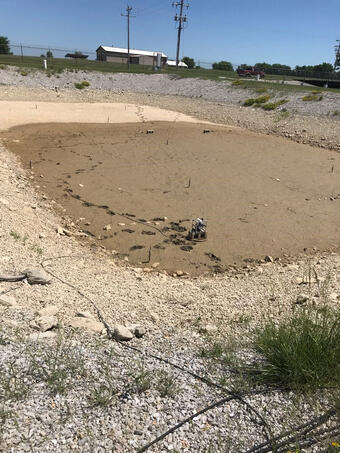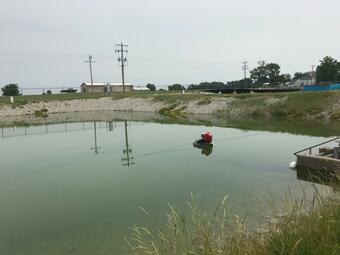Assessment of Acoustic Stimuli for Manipulating Movement of Bigheaded Carps
Invasive Silver Carp Hypophthalmichthys molitrix and Bighead Carp Hypophthalmichthys nobilis, hereafter referred to as bigheaded carps, have displayed a negative phonotactic response when presented with a broadband acoustic stimulus. Additional study is needed to identify effective acoustic stimuli for manipulating bigheaded carp behavior, and to test bigheaded carp responses to those stimuli in the field.

The Issue: The USGS is part of the Asian Carp Regional Coordinating Committee (ACRCC) and is focused on the research and development of techniques that could help managers better control Asian Carp populations. Techniques are needed to keep invasive carps from moving above lock and dam structures, and to move aggregations into areas where they can be more efficiently harvested.
Addressing the Issue: In mesocosm experiments, bigheaded carps have displayed negative phonotaxis in response to a broadband acoustic stimulus (Vetter et al. 2015, 2017). This response needs to be further evaluated to determine whether such behavior would occur in the natural environment. The effectiveness of a single stimulus would likely wane over time, therefore the identification of additional stimuli that elicit similar responses is important. In 2018, a rapid behavioral assessment of numerous acoustic stimuli was conducted at the US Army Corps of Engineers Research and Development Center in Vicksburg, MS. Three of those stimuli that elicited a negative phonotactic response were then evaluated more thoroughly in pond studies conducted at the USGS Columbia Environmental Research Center. Our goal is to identify sounds that could be incorporated into an acoustic array to deter bigheaded carps from moving upriver. Other members of the ACRCC have estimated that through strategic deterrence and harvest, populations of bigheaded carp may be controlled more effectively.
The playback of sounds associated with feeding has been shown to attract Ostariophysan fishes (Holt and Johnston 2011). Preliminary trials have demonstrated that bigheaded carps may be attracted to the playback of conspecific feeding sounds. Several different feeding sounds were recorded during feeding in ponds, then tested in the laboratory. The attraction of bigheaded carps to these sound stimuli will be further examined in pond studies. Conditioning of fish using this technique may be used as a method of early detection in regions at the invasion front. It may also be effective for enhancing the harvest of bigheaded carps.

Next Steps/Future Steps/Results: Future research in 2019 will continue to identify and evaluate new acoustic stimuli that may elicit a negative phonotactic response. Field implementation and evaluation of an experimental acoustic deterrent array is also planned for 2019. Further testing of conspecific feeding sounds as attractants will also occur in 2019.
Cited References:
Vetter, B.J., Cupp, A.R., Fredricks, K.T., Gaikowski, M.P., and Mensinger, A.F., 2015, Acoustical deterrence of Silver Carp (Hypophthalmichthys molitrix): Biological Invasions, v. 17, no. 12, p. 3383-3392.
Vetter, B.J., Murchy, K.A., Cupp, A.R., Amberg, J.J., Gaikowski, M.P., and Mensinger, A.F., 2017, Acoustic deterrence of bighead carp (Hypophthalmichthys nobilis) to a broadband sound stimulus: Journal of Great Lakes Research, v. 43, no. 1, p. 163-171.
Holt, D.E., and Johnston, C.E., 2011, Can you hear the dinner bell? Response of cyprinid fishes to environmental acoustic cues: Animal Behaviour, v. 82, no. 3, p. 529-534.
Return to Conservation, Quantitative, and Restoration Ecology
Return to Invasive Species Ecology
Below are other science projects associated with this project.
Use and Evaluation of Stimuli for Herding Bigheaded Carps to Increase their Capture Efficiency
Development and Evaluation of Novel Capture Gears for Bigheaded Carps
Chemical Attractant Investigations to Increase Aggregation and Harvest for the Control of Asian Carp
Assessment of newly developed acoustic stimuli for manipulating movement of bigheaded carps
Evaluation of a broadband sound as a deterrent for bigheaded carps at the Emiquon Preserve (Lewistown, Illinois)
Bioacoustic manipulation of invasive Bigheaded carp
Invasive Silver Carp Hypophthalmichthys molitrix and Bighead Carp Hypophthalmichthys nobilis, hereafter referred to as bigheaded carps, have displayed a negative phonotactic response when presented with a broadband acoustic stimulus. Additional study is needed to identify effective acoustic stimuli for manipulating bigheaded carp behavior, and to test bigheaded carp responses to those stimuli in the field.

The Issue: The USGS is part of the Asian Carp Regional Coordinating Committee (ACRCC) and is focused on the research and development of techniques that could help managers better control Asian Carp populations. Techniques are needed to keep invasive carps from moving above lock and dam structures, and to move aggregations into areas where they can be more efficiently harvested.
Addressing the Issue: In mesocosm experiments, bigheaded carps have displayed negative phonotaxis in response to a broadband acoustic stimulus (Vetter et al. 2015, 2017). This response needs to be further evaluated to determine whether such behavior would occur in the natural environment. The effectiveness of a single stimulus would likely wane over time, therefore the identification of additional stimuli that elicit similar responses is important. In 2018, a rapid behavioral assessment of numerous acoustic stimuli was conducted at the US Army Corps of Engineers Research and Development Center in Vicksburg, MS. Three of those stimuli that elicited a negative phonotactic response were then evaluated more thoroughly in pond studies conducted at the USGS Columbia Environmental Research Center. Our goal is to identify sounds that could be incorporated into an acoustic array to deter bigheaded carps from moving upriver. Other members of the ACRCC have estimated that through strategic deterrence and harvest, populations of bigheaded carp may be controlled more effectively.
The playback of sounds associated with feeding has been shown to attract Ostariophysan fishes (Holt and Johnston 2011). Preliminary trials have demonstrated that bigheaded carps may be attracted to the playback of conspecific feeding sounds. Several different feeding sounds were recorded during feeding in ponds, then tested in the laboratory. The attraction of bigheaded carps to these sound stimuli will be further examined in pond studies. Conditioning of fish using this technique may be used as a method of early detection in regions at the invasion front. It may also be effective for enhancing the harvest of bigheaded carps.

Next Steps/Future Steps/Results: Future research in 2019 will continue to identify and evaluate new acoustic stimuli that may elicit a negative phonotactic response. Field implementation and evaluation of an experimental acoustic deterrent array is also planned for 2019. Further testing of conspecific feeding sounds as attractants will also occur in 2019.
Cited References:
Vetter, B.J., Cupp, A.R., Fredricks, K.T., Gaikowski, M.P., and Mensinger, A.F., 2015, Acoustical deterrence of Silver Carp (Hypophthalmichthys molitrix): Biological Invasions, v. 17, no. 12, p. 3383-3392.
Vetter, B.J., Murchy, K.A., Cupp, A.R., Amberg, J.J., Gaikowski, M.P., and Mensinger, A.F., 2017, Acoustic deterrence of bighead carp (Hypophthalmichthys nobilis) to a broadband sound stimulus: Journal of Great Lakes Research, v. 43, no. 1, p. 163-171.
Holt, D.E., and Johnston, C.E., 2011, Can you hear the dinner bell? Response of cyprinid fishes to environmental acoustic cues: Animal Behaviour, v. 82, no. 3, p. 529-534.
Return to Conservation, Quantitative, and Restoration Ecology
Return to Invasive Species Ecology
Below are other science projects associated with this project.







